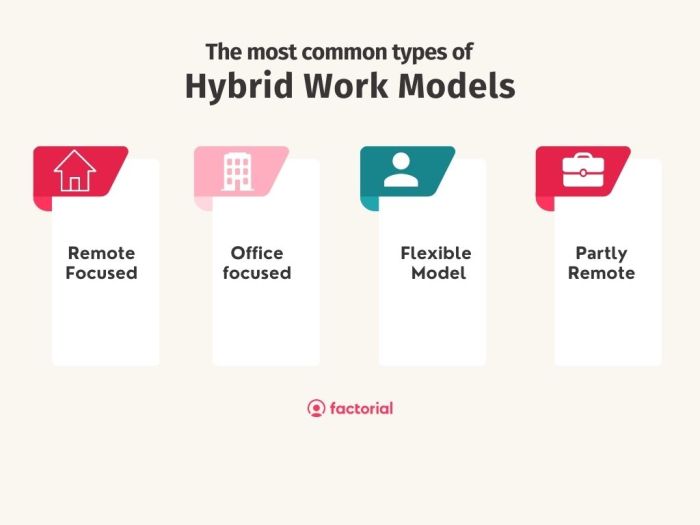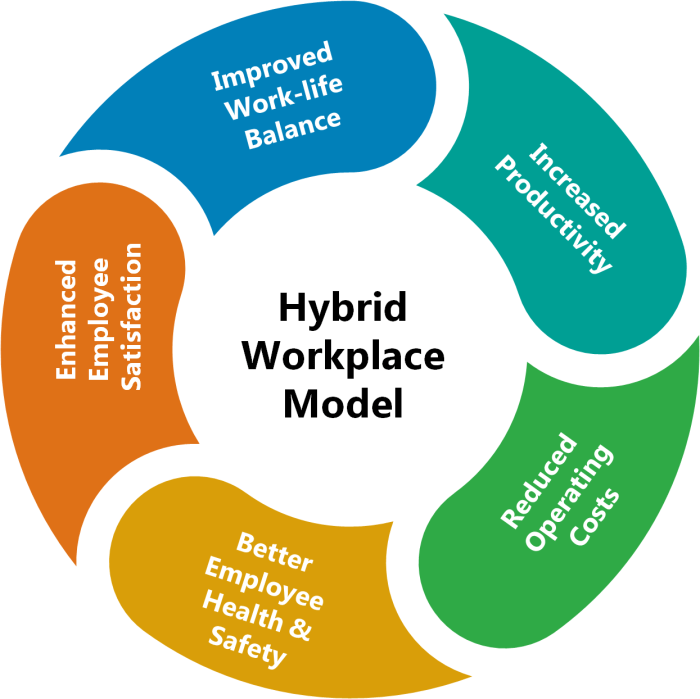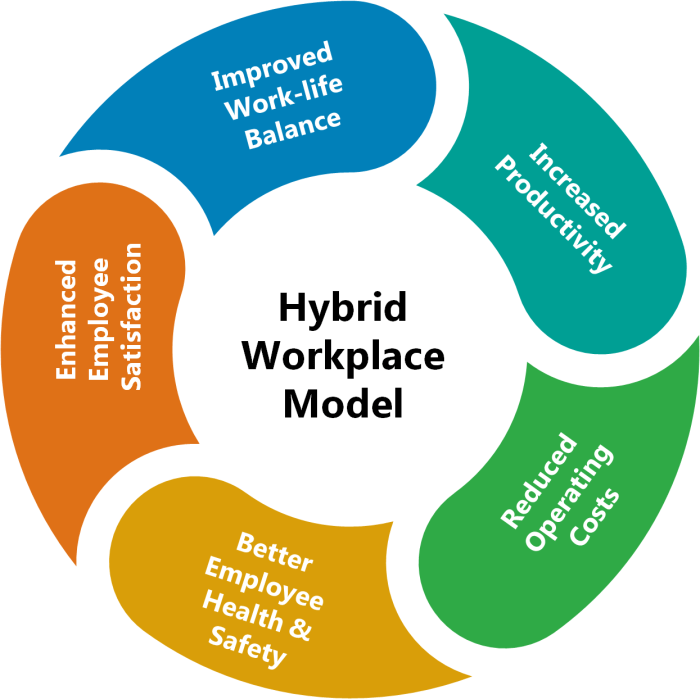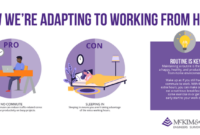Will non linear work days be the new hybrid working – Will non-linear work days be the new hybrid working? This question is on the minds of many as we navigate the evolving landscape of work. The traditional 9-to-5, five-days-a-week model is fading, replaced by a growing desire for flexibility and work-life balance.
Non-linear work days, with their emphasis on adaptability and individual preferences, are emerging as a potential solution, offering a new way to structure our work lives.
From compressed workweeks to flextime and remote work arrangements, non-linear work days come in various forms, each tailored to different needs and preferences. This shift towards a more flexible approach to work has the potential to revolutionize the way we work, impacting productivity, employee morale, and even the very definition of “work” itself.
The Rise of Non-Linear Work Days
The traditional 9-to-5 workday is becoming increasingly obsolete as more and more companies embrace flexible work arrangements. The rise of remote work and the increasing demand for work-life balance have led to the emergence of non-linear work days, a new hybrid working model that allows employees to tailor their schedules to their individual needs and preferences.
Defining Non-Linear Work Days
Non-linear work days are characterized by flexible schedules that allow employees to work when they are most productive and efficient. This can involve working during non-traditional hours, taking breaks throughout the day, or even working in short bursts throughout the week.
The key difference between non-linear work days and traditional schedules is the absence of a fixed, rigid structure.
Examples of Non-Linear Work Days
- An employee may choose to work from home during the morning hours, take a break in the afternoon to run errands, and then return to work in the evening.
- Another employee may prefer to work in short bursts throughout the day, taking breaks to exercise or spend time with family.
- Some employees may choose to work a compressed workweek, such as four days a week with longer hours.
Factors Driving the Shift to Non-Linear Work Days
Several factors are contributing to the growing popularity of non-linear work days:
- Employee Preferences for Flexibility:Employees are increasingly demanding flexible work arrangements that allow them to balance their work and personal lives. They want the freedom to work when they are most productive and to take breaks when they need them.
- Advances in Technology:Technology has made it easier for employees to work remotely and access information from anywhere. This has made it possible for companies to adopt more flexible work arrangements.
- Focus on Work-Life Balance:The emphasis on work-life balance has led companies to recognize the importance of providing employees with flexible work arrangements to help them manage their responsibilities outside of work.
- Increased Productivity:Studies have shown that employees who have more flexibility in their work schedules are often more productive. This is because they are able to work when they are most focused and energized.
Benefits of Non-Linear Work Days
Non-linear work days offer numerous benefits for both employees and employers. For employees, these benefits include:
- Increased flexibility and control over their work schedules.
- Improved work-life balance.
- Greater autonomy and independence.
- Reduced stress and burnout.
Challenges of Non-Linear Work Days
While non-linear work days offer many benefits, they also present some challenges:
- Maintaining Work-Life Boundaries:It can be difficult for employees to maintain a clear separation between work and personal life when they have flexible schedules.
- Communication and Collaboration:Non-linear work days can make it challenging to communicate and collaborate with colleagues who are working on different schedules.
- Managing Time Effectively:Employees need to be able to manage their time effectively to ensure that they are completing their work on time.
Defining Non-Linear Work Days

The traditional 9-to-5 workday, with its rigid structure and fixed hours, is becoming increasingly outdated in a world where flexibility and adaptability are paramount. Non-linear work days offer a refreshing alternative, embracing a more fluid and dynamic approach to work.
This concept allows individuals to tailor their work schedules to their personal needs and preferences, fostering a better work-life balance and enhanced productivity.
Examples of Non-Linear Work Day Structures
Non-linear work days encompass a variety of flexible arrangements, each catering to different needs and preferences. These structures empower individuals to work when they are most productive and efficient, maximizing their output while minimizing stress and burnout.
- Compressed Workweeks:This structure allows employees to work longer hours within a shorter period, typically condensing a 40-hour workweek into four days. For example, an employee might work 10 hours a day for four days, leaving the remaining three days for personal commitments or leisure activities.
Check what professionals state about if european smes are going to survive they need tech more than ever and its benefits for the industry.
This arrangement can provide employees with greater flexibility and time for personal pursuits, while still meeting the requirements of their job.
- Flextime:Flextime offers employees the flexibility to adjust their start and end times within a predetermined range. This allows employees to better manage their personal commitments, such as childcare or elder care, while still fulfilling their work responsibilities. For instance, an employee might choose to arrive later in the morning and leave earlier in the afternoon, or vice versa, depending on their individual needs.
This arrangement fosters a more balanced work-life integration, reducing stress and increasing job satisfaction.
- Remote Work Arrangements:Remote work, or working from home, allows employees to perform their duties from a location outside of the traditional office environment. This arrangement provides employees with greater flexibility and autonomy, allowing them to work from anywhere with an internet connection.
For instance, an employee might choose to work from home, a co-working space, or a coffee shop, depending on their preference and the nature of their work. Remote work arrangements can significantly improve work-life balance, reduce commuting time, and increase productivity, as employees are often less distracted and more comfortable in their chosen work environment.
Comparing Non-Linear Work Days with Traditional Work Schedules
Non-linear work days differ significantly from traditional work schedules in several key aspects:
- Flexibility:Non-linear work days offer greater flexibility, allowing employees to adjust their work hours and locations to suit their personal needs and preferences. Traditional work schedules, on the other hand, are rigid and inflexible, requiring employees to adhere to a set schedule regardless of their individual circumstances.
- Adaptability:Non-linear work days are highly adaptable, allowing employees to adjust their work schedules to accommodate changing priorities and circumstances. Traditional work schedules are less adaptable, making it difficult for employees to respond to unexpected events or changes in their personal lives.
- Work-Life Balance:Non-linear work days promote a better work-life balance, allowing employees to integrate their work and personal lives more effectively. Traditional work schedules can often lead to work-life conflict, as employees struggle to balance their work responsibilities with their personal commitments.
Benefits of Non-Linear Work Days: Will Non Linear Work Days Be The New Hybrid Working

The rise of non-linear work days is not just a trend; it’s a paradigm shift in how we approach work. This new model, characterized by flexible schedules and a focus on outcomes, offers numerous benefits for both employees and employers.
It allows for greater autonomy, promotes a healthier work-life balance, and can lead to increased productivity and engagement.
Increased Productivity and Efficiency
Non-linear work days empower employees to work when they are most productive. By allowing individuals to tailor their schedules to their personal rhythms and preferences, they can maximize their focus and efficiency. This can lead to a significant increase in output, as employees are more likely to be engaged and motivated when working during their peak performance hours.
“A study by Stanford University found that employees who work flexible hours are 13% more productive than those who stick to a traditional 9-to-5 schedule.”
Improved Employee Morale and Well-being
Non-linear work days foster a sense of trust and autonomy among employees, leading to increased job satisfaction and a more positive work environment. By providing flexibility, employers demonstrate their confidence in their employees’ ability to manage their time effectively and achieve their goals.
This can result in a more engaged and motivated workforce, leading to lower stress levels and improved overall well-being.
“A survey by FlexJobs found that 77% of employees who work remotely feel less stressed than those who work in a traditional office setting.”
Enhanced Work-Life Balance
Non-linear work days allow employees to better integrate their work and personal lives. By having the flexibility to adjust their schedules, they can attend to personal commitments, such as childcare, eldercare, or other appointments, without sacrificing their professional responsibilities. This can lead to a healthier work-life balance, reducing stress and improving overall well-being.
“A study by the University of Chicago found that employees who have more control over their work schedules are happier and healthier than those who do not.”
Attracting and Retaining Top Talent
In today’s competitive job market, offering flexible work arrangements, including non-linear work days, is becoming increasingly important for attracting and retaining top talent. Many skilled professionals value flexibility and autonomy, and companies that offer these benefits are more likely to attract and retain a diverse and talented workforce.
“A survey by LinkedIn found that 75% of professionals consider flexible work arrangements to be a top priority when considering new job opportunities.”
Challenges of Non-Linear Work Days
While non-linear work days offer numerous benefits, implementing them effectively requires careful consideration of potential challenges. These challenges can arise from various aspects of work, including communication, accountability, and team cohesion. Successfully navigating these hurdles is crucial for maximizing the benefits of non-linear work days.
Managing Communication
Effective communication is essential for any successful work environment, but it becomes even more critical in non-linear work days. The flexibility of non-linear work days can lead to dispersed teams, asynchronous communication, and varying work schedules. This can create communication gaps, leading to misunderstandings and delays.
- Establish Clear Communication Channels:Define specific communication channels for different purposes, such as project updates, team discussions, and urgent matters. This helps ensure that messages reach the right people at the right time. Examples include dedicated project management platforms, instant messaging apps, and video conferencing tools.
- Embrace Asynchronous Communication:Encourage the use of asynchronous communication tools like email, project management software, and collaborative documents. This allows team members to work at their own pace and respond when it’s convenient for them.
- Regular Check-Ins:Schedule regular team meetings, both synchronous and asynchronous, to ensure everyone is on the same page and to address any outstanding issues. These check-ins can be in the form of virtual team meetings, project updates, or brief status reports.
Ensuring Accountability, Will non linear work days be the new hybrid working
In traditional work environments, accountability is often tied to physical presence and supervision. Non-linear work days, however, require different approaches to ensuring accountability. Without the traditional framework, it can be challenging to track progress and ensure tasks are completed on time.
- Clearly Defined Goals and Expectations:Set clear and measurable goals for each project or task. Ensure that all team members understand their individual responsibilities and deadlines.
- Regular Progress Updates:Implement a system for tracking progress and reporting on task completion. This could involve daily or weekly updates, progress reports, or the use of project management software.
- Feedback and Recognition:Provide regular feedback and recognition for individual and team achievements. This helps to maintain motivation and reinforces a culture of accountability.
Maintaining Team Cohesion
Non-linear work days can potentially lead to a decline in team cohesion, as team members may have limited opportunities for face-to-face interaction. This can hinder collaboration, creativity, and overall team spirit.
- Virtual Team-Building Activities:Organize virtual team-building activities to foster social connections and promote a sense of community. These activities can include online games, virtual happy hours, or shared project challenges.
- Regular Social Interactions:Encourage team members to schedule regular social interactions, even if they are virtual. This could involve virtual coffee breaks, lunch chats, or informal team meetings.
- Collaborative Projects:Assign projects that require collaboration and teamwork. This helps to promote communication, problem-solving, and a shared sense of accomplishment.
Impact on Productivity and Collaboration

The shift towards non-linear work days presents a unique opportunity to reimagine how we approach productivity and collaboration. This new paradigm, where work hours are flexible and adaptable to individual needs, can have a profound impact on both individual performance and team dynamics.
Impact on Individual Productivity
The potential impact of non-linear work days on individual productivity is multifaceted. While some may find that the flexibility empowers them to work more efficiently and effectively, others may struggle to maintain focus and manage their time effectively.
- Increased Flexibility and Autonomy: Non-linear work days can offer employees greater control over their schedules, allowing them to work during their most productive hours and take breaks when needed. This flexibility can lead to increased focus, motivation, and overall productivity. For example, a creative individual might find that they are most productive in the early morning hours, while a parent might prefer to work during their children’s nap time.
- Improved Work-Life Balance: Non-linear work days can help employees achieve a better balance between their professional and personal lives. This can lead to reduced stress, improved well-being, and ultimately, increased productivity. Studies have shown that employees with better work-life balance are more likely to be engaged and productive at work.
- Potential for Reduced Distractions: By working during their most productive hours, employees can minimize distractions and interruptions, leading to greater focus and efficiency. This can be particularly beneficial for tasks that require deep concentration, such as writing or coding.
Impact on Team Collaboration
Non-linear work days can also have a significant impact on team collaboration. While the flexibility can foster a more inclusive and adaptable work environment, it also poses challenges in maintaining team cohesion and communication.
- Enhanced Inclusivity: Non-linear work days can create a more inclusive work environment by accommodating the needs of employees with diverse schedules and commitments. This can lead to greater participation and engagement from all team members, fostering a more collaborative and productive team dynamic.
- Challenges in Maintaining Communication and Cohesion: When team members are working on different schedules, it can be challenging to maintain consistent communication and ensure that everyone is on the same page. This can lead to delays, misunderstandings, and a decline in team productivity.
Strategies for Maximizing Productivity and Collaboration
To ensure that non-linear work days lead to increased productivity and collaboration, organizations need to implement strategies that address potential challenges and leverage the benefits of this new work model.
- Clear Communication and Expectations: It is crucial to establish clear communication channels and expectations for how teams will work together in a non-linear work environment. This includes defining work hours, outlining communication protocols, and setting clear deadlines for tasks.
- Effective Tools and Technology: Organizations should invest in tools and technologies that facilitate communication and collaboration among team members, regardless of their location or work schedule. This could include project management software, video conferencing platforms, and instant messaging tools.
- Supportive Work Environment: A supportive work environment is essential for maximizing productivity and collaboration in a non-linear work model. This means fostering a culture of trust, respect, and flexibility, where employees feel empowered to manage their time effectively and work in a way that suits their individual needs.
The Future of Work
The concept of non-linear work days is not just a passing trend; it’s a glimpse into the future of work. As technology continues to evolve and the lines between work and personal life blur, the traditional 9-to-5 workday is becoming increasingly outdated.
Non-linear work days, with their flexibility and adaptability, are paving the way for a more dynamic and fulfilling work experience.
Evolution of Work Flexibility
The rise of non-linear work days is just one manifestation of a broader shift towards work flexibility. This trend is driven by several factors, including:
- Technological Advancements:Tools like video conferencing, project management software, and cloud-based collaboration platforms have made it possible for employees to work effectively from anywhere, at any time.
- Changing Employee Expectations:Younger generations, in particular, prioritize work-life balance and flexibility. They are less likely to be satisfied with rigid work schedules and are more likely to seek employers who offer flexibility.
- The Rise of the Gig Economy:The gig economy has normalized the idea of working on multiple projects for different clients, often on flexible schedules. This has further fueled the demand for work flexibility.
The Future of Non-Linear Work Days
Imagine a future where non-linear work days are the norm. In this scenario, employees would have complete autonomy over their work schedules. They could choose to work during peak productivity hours, take breaks when they need them, and even work from different locations.
This could lead to a number of positive outcomes for both individuals and organizations:
- Increased Productivity:By working during their most productive hours, employees could achieve more in less time. This could lead to increased efficiency and productivity across the board.
- Improved Work-Life Balance:Employees could better manage their work and personal lives, leading to reduced stress and increased job satisfaction.
- Attracting and Retaining Top Talent:Offering non-linear work days could make organizations more attractive to top talent, who are increasingly seeking flexibility and autonomy.
Challenges and Considerations
While the future of non-linear work days is promising, there are also challenges to consider:
- Maintaining Team Cohesion:With employees working on different schedules and from different locations, it will be important to find ways to maintain team cohesion and communication.
- Managing Time Effectively:Without clear boundaries between work and personal life, it can be challenging to manage time effectively and avoid burnout.
- Ensuring Equitable Access to Opportunities:It’s important to ensure that all employees have access to the same opportunities and resources, regardless of their work schedule or location.
Non-Linear Work Days: A New Era of Work
The future of work is likely to be characterized by flexibility, autonomy, and a focus on results rather than hours worked. Non-linear work days will play a crucial role in this new era, allowing employees to work in a way that suits their individual needs and preferences.
While challenges remain, the potential benefits of non-linear work days are significant, making it a concept worth exploring and embracing.





